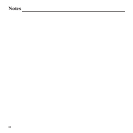
• Press the buttons lightly.
• Use the special features that are designed to
minimize the times of pressing buttons, such as
Message Templates and Predictive Text.
• Take many breaks to stretch and relax.
Emergency Calls
This phone, like any wireless phone, operates using
radio signals, which cannot guarantee connection in all
conditions. Therefore, you must never rely solely on any
wireless phone for emergency communications.
Loud Noise
This phone is capable of producing loud noises, which
may damage your hearing. Turn down the volume
before using headphones, Bluetooth stereo headsets or
other audio devices.
Phone Heating
Your phone may become warm during charging and
during normal use.
Electrical Safety
Accessories
Use only approved accessories. Do not connect with
incompatible products or accessories. Take care not to
touch or allow metal objects, such as coins or key rings,
to contact or short-circuit the battery terminals. Never
puncture the surface of the battery with sharp objects.
For Your Safety
85
Connection to a Car
Seek professional advice when connecting a phone
interface to the vehicle electrical system.
Faulty and Damaged Products
Do not attempt to disassemble the phone or its
accessories. Only qualified personnel can service or
repair the phone or its accessories. If your phone (or its
accessories) has been submerged in water, punctured,
or subjected to a severe fall, do not use it until you have
taken it to be checked at an authorized service center.
CTIA Requirements
• Do not disassemble or open, crush, bend or deform,
puncture, or shred.
• Do not modify or remanufacture, attempt to insert
foreign objects into the battery, immerse or expose
to water or other liquids, expose to fire, explosion or
other hazard.
• Only use the battery for the system for which it is
specified.
• Only use the battery with a charging system that has
been qualified with the system per CTIA Certification
Requirements for Battery System Compliance to IEEE
1725. Use of an unqualified battery or charger may
present a risk of fire, explosion, leakage, or other
hazard.
• Do not short-circuit a battery or allow metallic
conductive objects to contact battery terminals.
• Replace the battery only with another battery that
has been qualified with the system per this standard,
IEEE-Std-1725. Use of an unqualified battery may
present a risk of fire, explosion, leakage or other
hazard.
• Promptly dispose of used batteries in accordance
with local regulations.
• Battery usage by children should be supervised.
• Avoid dropping the phone or battery. If the phone or
battery is dropped, especially on a hard surface, and
the user suspects damage, take it to a service center
for inspection.
• Improper battery use may result in a fire, explosion,
or other hazard.
• The phone shall only be connected to CTIA certified
adapters, products that bear the USB-IF logo or
products that have completed the USB-IF compliance
program.
Radio Frequency Interference
General Statement on Interference
Care must be taken when using the phone in close
proximity to personal medical devices, such as
pacemakers and hearing aids.
Pacemakers
Pacemaker manufacturers recommend that a minimum
separation of 15 cm be maintained between a mobile
phone and a pacemaker to avoid potential interference
with the pacemaker. To achieve this, use the phone on
For Your Safety
84
the opposite ear to your pacemaker and do not carry it
in a breast pocket.
Hearing Aids
People with hearing aids or other cochlear implants
may experience interfering noises when using wireless
devices or when one is nearby. The level of interference
will depend on the type of hearing device and the
distance from the interference source. Increasing the
separation between them may reduce the interference.
You may also consult your hearing aid manufacturer to
discuss alternatives.
Medical Devices
Please consult your doctor and the device manufacturer
to determine if operation of your phone may interfere
with the operation of your medical device.
Hospitals
Turn off your wireless device when requested to do
so in hospitals, clinics or health-care facilities. These
requests are designed to prevent possible interference
with sensitive medical equipment.
Aircraft
Turn off your wireless device whenever you are
instructed to do so by airport or airline staff. Consult the
airline staff about the use of wireless devices onboard
the aircraft. If your device offers a ‘flight mode’, this
must be enabled prior to boarding an aircraft.


















